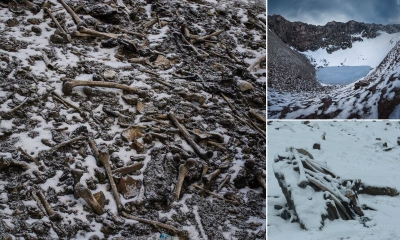
During World War II. an Indian forest Ranger called Hari Kishan Madhwa made a morbid discovery in a remote glacier lake in the Himalayas in Uttarakhand. Something strange was visible in its clear water. On closer inspection, it was revealed that the lake was full of human skeletons. It came to be known as Roop Kund or Skeleton Lake. A DNA sample of 38 skeletons showed that they came from three genetically distinct groups. Who were these people? When did they die? How did they die? Where did they come from?
One old theory associates the remains to an Indian king, his wife and their attendants, all of whom perished in a blizzard some 870 years ago.
Another suggests that some of the remains are of Indian soldiers who tried to invade Tibet in 1841, and were beaten back. More than 70 of them were then forced to find their way home over the Himalayas and died on the way.
Yet another assumes that this could have been a “cemetery” where victims of an epidemic were buried. In villages in the area, there’s a popular folk song that talks about how Goddess Nanda Devi created a hail storm “as hard as iron” which killed people winding their way past the lake. India’s second-highest mountain, Nanda Devi, is revered as a goddess.
Earlier studies of skeletons have found that most of the people who died were tall – “more than average stature”. Most of them were middle-aged adults, aged between 35 and 40. There were no babies or children. Some of them were elderly women. All were of reasonably good health.
Also, it was generally assumed that the skeletons were of a single group of people who died all at once in a single catastrophic incident during the 9th Century.
Scientists genetically analysed and carbon-dated the remains of 38 bodies, including 15 women, found at the lake – some of them date back to around 1,200 years. They found that the dead were both genetically diverse and their deaths were separated in time by as much as 1,000 years.
But more interestingly, the genetics study found the dead comprised a diverse people: one group of people had genetics similar to present-day people who live in South Asia, while the other “closely related” to people living in present-day Europe, particularly those living in the Greek island of Crete. Also, the people who came from South Asia “do not appear to come from the same population”.
Genetic studies found no evidence of the presence of any ancient bacterial pathogen that could provide disease as an explanation for the cause of deaths.
Credit : BBC
Picture Credit : Google




